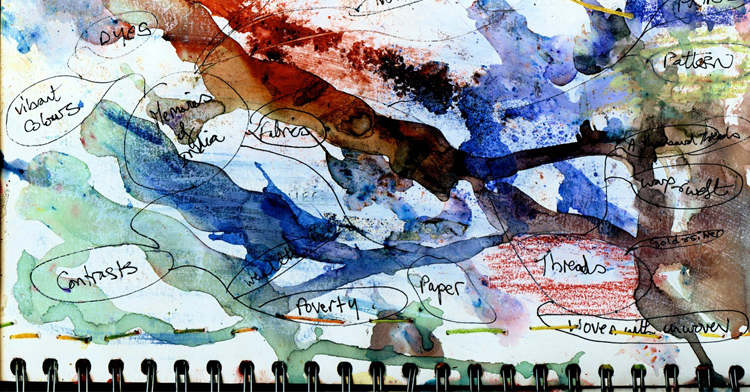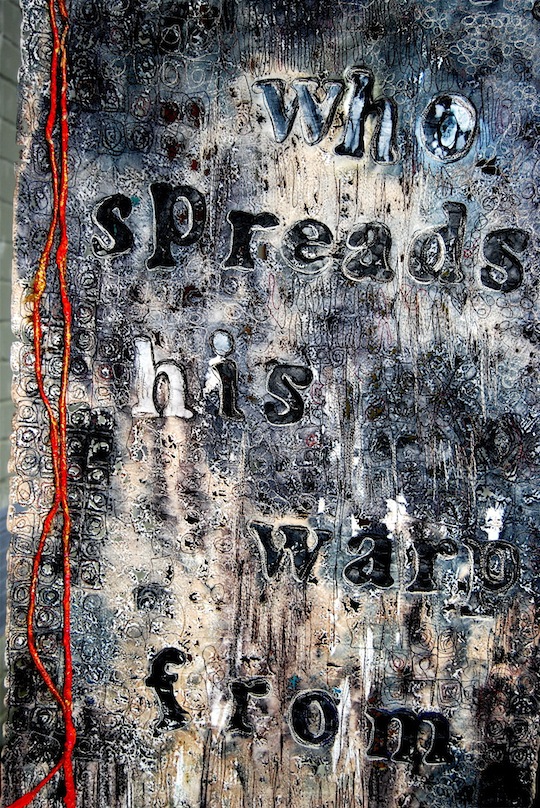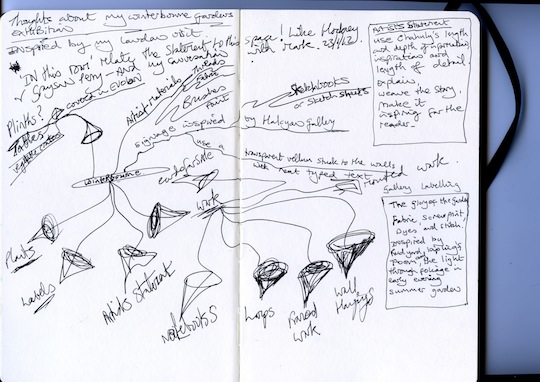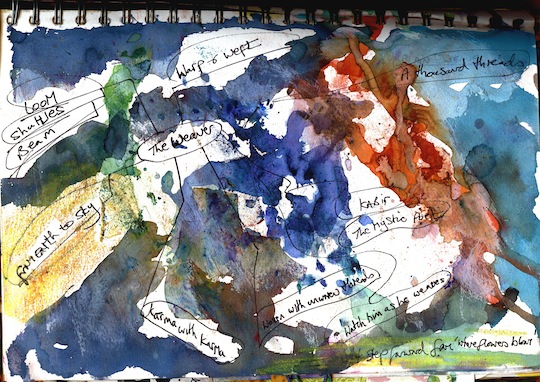Bren Moody: Sketchbooks and mind mapping for artists

After a career in marketing, Bren Moody (previously Boardman) sent her business clothes and briefcase to a charity shop, bought several pairs of jeans and took herself off to study art and textiles.
Four years later, in 2003 she graduated with a 1st class (Hons) degree in Printed Textiles from Loughborough University before establishing herself as a freelance textile artist, teacher and mentor from her home studio in Warwickshire. She combines her love of texture and vivid colours with her passion for gardening, to produce original pictures, wall hangings, prints and cards that are exhibited in galleries, shops and through her website.
During her studies and whilst teaching freelance at University, College and branches of the Quilters Guild and other textile-related Guilds, Bren developed a process using sketchbooks and mind maps to help students develop an idea through to an original piece of work. In this article, Bren shares her process and explains how she uses the formula to help produce her gallery art textiles.

Bren Moody – The Weaver wall hanging (detail)
Developing artistic muscle
My studio shelves are filled with my many sketchbooks of all shapes and sizes, that span over 15 years of my ideas, some developed, some random – combining photos, lists, drawings, postcards, scraps of samples, and other paraphernalia.
I have always urged students to help their own creative process by working in sketchbooks, journals, scrapbooks, diaries, call them whatever you want, but to use them as an important place to gather any visual research and thoughts. Sketchbooks are often art projects in themselves or can be the stepping stone to further development in any media you choose.
Occasionally, my own work seems to skip the sketchbook stage and starts straight onto the “canvas” without any early sketchbook development. But has it really appeared out of nowhere? I don’t think so! Just as with athletes developing muscle in training, artists develop confidence and ideas through practice in using their sketchbook to test paints, draw ideas, jot down thoughts, stitch random samples… these are all practice to help build “artistic muscle” or “mileage on the pencil”!
So, when I appear to produce a picture without backup work, this is unlikely to be the case. If you were to watch me draw a flower onto a background fabric, then you were to delve into some of my sketchbooks, you would be sure to find similar colour combinations, flower drawing or stitching method. We do not come to this without some practice and a sketchbook is a form of organising this process.

Bren Moody – Mind map for exhibition plan
Mindmaps
When I start a new sketchbook I try to reserve the first two facing pages to produce a mindmap so I can keep referring back to my notes and ideas during the project.
If, like me, your head is full of ideas for a project and you don’t know where to start, then consider adopting this practice and using the first page of your sketchbook to draw a mindmap. A mindmap is a diagram starting in the centre of a blank page where you write a keyword or phrase. From this central “idea” you can draw branches and sub-branches to write associated words, ideas and even images that all relate to your main idea. Since the brain doesn’t usually think in list fashion, but randomly, then the shape of this tree-like structure can help aid your creativity and serve as a dumping place during the project process.
Creating sketchbook pages
A few guidelines can help you if you are shy of starting a sketchbook, starting with my three Rules:
Rule 1
Different objects need different materials and implements to draw with
Rule 2
Remember the Visual Language of Art, including Line, Shape, Colour, Tone, Texture, Pattern, Form
Rule 3
Remember why you are doing this – To record visual information, observations, ideas, thoughts, experiences
Consider what kind of sketchbook you might like to make? For example:
- Reference: Process mapping e.g. colour mixing tests, storage place for samples and swatches
- Idea generation: Forming a mind map and process from idea to outcome (see below for help in formulating your Plan)
- To record a journey: Mental or physical e.g. holiday in Wales, my gardening year
If you still find sketchbooking a big step, then try to vary its contents:
- Photos, photocopies, prints
- Magazine or newspaper cuttings
- Drawings, sketches, doodles
- Text, poetry, stories, thoughts, letters, extracts, statements, words
- Colour – paint, crayons, pencils
- Fabrics, Threads, Wools
- Beads, Buckles, Buttons – but in moderation!
- Papers of all kinds
How to formulate a plan – From idea to outcome
During my years of teaching my Explore your Creative Potential workshops at The Bramble Patch, I devised a process to help my students to develop their own style through self-directed project work. Under my guidance, each individual prepared a plan for the year for study taking the following questions and examining each aspect in turn.
Concept – What is my idea? What shall I explore?
Influences – Who/What is going to be an inspiration for me?
Techniques – How shall I explore my idea?
Developing the Designs – What constitutes a body of samples? What considerations do I need to employ?
Contexts – What are the possible outcomes for my idea?
Evaluation – What are my criteria for judging my success?
Result – Where do I hope this will lead?
The planning process was especially valuable in helping students stay on track, measure where they were in the process at what time and measure the outcome so they could answer the all-important question “where to now?”.

Bren Moody – Mindmap for The Weaver
Mind map of The Weaver
To demonstrate the plan in action, I’m using a project based on a holiday trip to India where I chanced upon a poem written by Kabir, the Mystic Poet, some 600 years earlier. When I returned home, I started a sketchbook with a mind map ‘Memories of India’ and a further mind map with thoughts about the poem, The Weaver.
The Weaver – poem by Kabir, the Mystic Poet
How many know of the weaver?
who spreads his warp
from earth to sky.
The two beams of his loom,
the sun and the moon.
Two shuttles filled with
a thousand threads
spread lengthwise.
Watch him as he weaves,
Karma with Karma
woven with unwoven threads.
How well this weaver weaves.
The mind maps helped me unravel many thoughts about my trip and I went on to produce a Project Plan to help formulate my ideas towards a tangible outcome. I was able to revisit my plan at each stage of my development to check my progress and alter the plan if needed to suit my creative direction. Without a plan, I have a tendency to go off in many directions and “loose the plot!”

A weaver at work
The Weaver poem project plan
Concept: What is my idea? What shall I explore?
India challenged me with its sheer excess of colour, noise, imagery and, of course, textiles. The quiet moment when I chanced across the poem written on the wall of an Indian Weaver’s ancient house “museum” stands out as a clear memory. I want to explore how to use the words in a piece of new work for an exhibition in Stratford-on-Avon, Warwickshire.
Influences: Who/What is going to be an inspiration for me?
I want to study artists using text as a key focus in their work, especially textile artists like Jette Clover, The Kemshalls and contemporary imagery by Joan Shulze. Since I only produced a tiny sketchbook in India, I want to concentrate on producing a larger book using Gwen Diehn’s The Decorated Journal and The Decorated Page.
Techniques: How shall I explore my idea?
- Work on different methods of putting text onto Lutradur
- Develop a colour plan to reflect the mood of the moment and the museum wall where I first saw the poem.
- Use hand and machine stitch with imagery to develop ideas further.
Development of Designs: What constitutes a body of samples? What considerations do I need to employ?
My aim is to produce a sketchbook and a finished piece of work or works based on my recent trip to India and on the poem, The Weaver. Several samples showing different methods of putting text onto Lutradur, background colours resolved and consideration given to the mood of the poem, as my own interpretation.
Contexts: What are the possible outcomes for my idea?
With an exhibition deadline looming, I would like to add a new original piece of text-based artwork to my finished works. I would like to have an impact piece that might fit into an unusual place in the venue. There is a long narrow window that could be utilised.
Evaluation: What are my criteria for judging my success?
I’m standing in the venue looking at my new finished piece. In my mind, It is an exciting interpretation of the poem and use of text on fabric. The work will be available for sale, so further success will be to sell the piece.
Result: Where do I hope this will lead?
- Resolving a new technique for putting text onto Lutradur.
- A beautiful sketchbook on India produced, inspired by my trip.
- A new piece of original gallery textile art that I can proudly show, having resolved lots of the stages on my Project Plan.

Bren Moody – The Weaver
My efforts resulted in the longest wallhanging I had produced, 2.5m High x 50cm wide. I used only a couple of lines from the poem, but I felt the result worked. I coloured the Lutradur with many layers of acrylics in charcoal greys, rusts and golds, adding a verdigris chemical for textiles that helped with the aged look. I used large block printing letters for the text and hand-painted them before machine stitching shadows and highlights to achieve a three-dimensional effect. The outcome was a piece that looked quite drab but magical when the light caught the text and the gold paint. And the piece sold!
I’ve since made several very large hangings, used text in several pieces of exhibition work and as a result of using the venue window to show my piece, I’ve shown many of my wall hangings in gardens where the light through the material gives a wonderful sense of belonging to the piece. Project Planning helps keep me on track, focusing my mind and, together with a weekly timetable, makes sure I reach my exhibition deadlines.
Further reading:
- Gwen Diehn – The Decorated Journal, also The Decorated Page
- Kay Greenlees – Creating Sketchbooks for Embroiderers and Textile Artists
- Jane Stobart – Extraordinary Sketchbooks
- Sketchbooks for textile artists by Lynne Butt
- Finding inspiration for textile art by Cas Holmes
To discover more about Bren Moody visit her on Instagram here
Ready to tap into the potential of your sketchbook to take your textile-based work onto a new level? Check out an opportunity to do just that here!
















For someone who rarely uses a sketchbook, this is quite intriguing 🙂
As someone relatively new to using sketchbooks as a starting point for a project, despite being 65, I found this article to be just what I needed to organise my approach to my work. Thanks
Just the prod I needed to explore this approach!
I want to create a piece of work based on a poem, your way of breaking things down appeals to me. I had forgotten about mind maps, I shall get down to it immediately!
Really confused by the previous comment, what has being 65 got to do with it? Been there, done that, heading for the next milestone!
Totally identify with age comment, suggest anyone feeling old should pin a copy of the poem “Warning” by Jenny Joseph on their workroom wall.
An a excellent interview, such a clear outline for the progression of a project from conception to completion, many tools and good sound advice on offer here.
This is the first time that I have actually come across an article that gives me concise, clear and in plain language how, when, and why to use a sketchbook. Wonderfully informative article with good suggestions for further reading.
Thanks everyone who left comments! Its great to get feedback and to know that my ideas are helpful. Working on some really easy “January blues lifting” studio work. Visit my website for tips and pictures!
Love the systematic approach. We tend to forget that a project is a project – whether for pure business or indulging our more creative side. Great advice, thank you. Lucy
The mystique of sketchbooks eluded me until I did a course with Bren a few years ago and it was an eye opener. The penny dropped as to the purpose of sketchbooks and I have kept several on the go ever since. They can become works of art in themselves and I get inspired anew when I look at my old books. Like earrings, a girl can never have enough sketchbooks!
Just embarking on a project to tell my life story through sketchbooks, including photos, memoirs, drawings …… ‘every Life has a Story’ says Roben-Marie Smith. Finding it very creative and absorbing to tell it this way.
Bren, I really appreciated your piece on Sketchbook and Mindmapping as I loved using them on my Foundation year at Chesterfield.
I’m ready to start again after a break and am excited again by the variety of your media and the way you organise yourself/work. I have begun creating a studio in my front bedroom, and already am fizzing with anticipation when I walk in there.
All the best, and many, many thanks
Ruth Nichol
Thank you. I have used mindmapping many times in the past but I hadn’t quite got around to using it for sketchbook work. Now I will!
Hello,
Thank you so much for your excellent information. I have never kept a serious sketchbook and often “fly off in all directions”. Following your advise I am going to get a book and start with the mind mapping. I am so looking forward to doing this and experiencing the creative process in a whole new way – can hardly wait to see the finished product – whatever it will be!
i use mind mapping for quilting as well! Something I learned at work I moved into my creative life. I use An apple app I found, as I have never done a journal. I think I may start now
Hi there. Check out our interview with Michael James;
So enjoyed reading a way to help organize my eclectic right brain and develop a plan to realize some growing ambitions in “arting ” and play. A “map” always helps on a journey. Thanks.
Such an inspirational article. The information is clear, concise and jam-packed full of great ideas. I can’t wait to start mind-mapping, it might help sort to jumble of ideas inside my head. Thanks!
I love using mind-maps, and your “road-map” for planning a project and staying on track (difficult – so many interesting off-shoots!) is excellent advice, and has made me rethink my art practice again. Thank you for sharing.
Thank you so much for this article. I agree with Trishaj, and like her, a senior artist, my journal skills are rather poor. This will help me tremendously in my studies, as my journaling will really improve, and my actual process of developing my ideas will be more easily expressed.
With a collection of EMPTY sketchbooks – I have now been re-motivated to design first! Thank you Bren.
Excellent article. Agreen with previous comments. Love how clear and concise instructions are. Intrigued by the mind mapping process.
Thank you for this article. Well written and sound advice at just the right time. A new year with new opportunities ahead, as a committed user of sketchbooks I feel inspired to root out a new one today and start a fresh project.
I really enjoyed reading this article. I hover between textiles and lampworking, attempting to combine them at times, and find sketchbooks my way of moving through my ideas. I have thought of mind maps before – even bought a book on them! It is definitely time to explore the idea again thanks to your article. I do get stuck at times and this could help a great deal.
I currently plan and trial new projects on odd scraps of paper and material, which, along with the photos and magazine scraps etc., get lost in the bottom of the cupboard on completion of the project. My first ever sketchbook is going to be on developing sketchbooks and mind maps with relation to textile art – and I can already feel it inspiring a new piece of textile art. An exciting project to start 2016 off on the right foot.
Thank you for this article. I have never been one for goal setting or mind maps as I felt the ideas were all in my head. Now I can see how helpful this will be as I often forget some great ideas until too late. Jo
Thank you for clear and inspiring ideas with structure to keep it on track. I particularly appreciated your explanation of how you used the techniques to produce your ‘Weaver’ piece. What a beautiful poem. This is definitely going to help me organise my project.
Hi
Hi thankyou for the revelation I’m studying with oca textiles to complete my degree and informed by new my tutor when submitting a colour assignment that my sketch book looked more like a scrap book with things stuck in and folded bits of paper.I was gob smacked and hurt as this I use to release my creative energy and ideas ,but I shall continue in my method and madness as it’s who I am,not mad but have a method,if that makes sense
A BIG thankyou.
Neil
Hi Bren, I have lots of sketch books in with no particular order.
Your mind map will be great with helping me to create sense of order and creativity in my textile/mix media.
Thank you
Lynn
Thats really helpful, I have lots of ideas but no idea how to approach them this gives me some structure in which to work and also to look at creating a sketchbook with samples
My life has got very chaotic and exceptionally busy the last few months with family illness and I keep thinking about a project that has a deadline but only in my head. I forget to write it down or collate my ideas in solid form and I know I lose so many ideas and then panic will set in. I’m going to use the mind-mapping to get myself back on track and this article has made me realise that I can work in my sketchbook in tiny time slots and so move forward in my project.
Proposal servant moved:
http://maria.forum.telrock.net
I found this really inspirational, I never plan my work but after reading this I intend to give it a go for my next piece / pieces of work which will hopefully be in an exhibition with a new and exciting exhibiting group
Thanks for the inspiration
Lillian
Hi Bren, Thank you so much for your article and introducing the idea of mind mapping to art. I echo Renate’s comment and others. While vaguely aware of the term, I had no idea about using it, or how it worked; I also echo other comments re – if you don’t write it down, ideas are forgotten very quickly, (as boring bits of) Life gets in the way. Having moved house recently, it’s had to get one’s head together. Sketchbooks – while I mean to use them, haven’t done so yet, despite having a great book on them (Shelley Rhodes). Too easy to flounder around; teaching yourself and experimenting…and you’ve shared so much; very succinctly, and I had to write to say a big Thank You from – Lynn, DownUnder!! Very best wishes for your future practice.
The best way to make you sketchbook creative (and spilling over) is to start treating it like a brain dump. Like a mother that you can talk to or a counselor who is obligated to listen quietly as you tell them every last useless detail of your life.